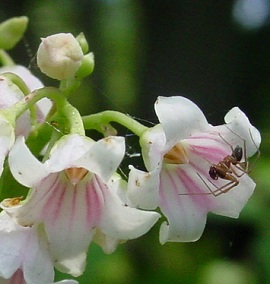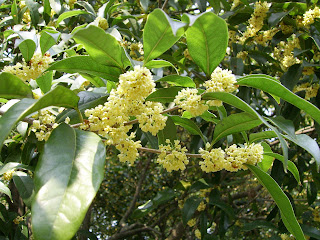The gladiolus is an easy-to-grow flower, especially valued for use in floral arrangements. Gladioli produce tall spikes of large blossoms, in a rainbow of colors. Only clear, true blue is missing; white, pink, red, purple, yellow, orange, salmon, and even green gladioli are available, along with many bi-colors.
"Glads" grow from corms (bulb-like structures) that are not winter-hardy in Minnesota. They must either be dug in September and stored until planting time the following May, or replaced annually. Some gladiolus experts recommend treating them as annuals because you are more likely to get large, healthy blooms each year that way, and you don't have to fuss with storing them.
Planting LayoutIf you are growing glads primarily for cut flowers, you may want to plant them in rows, as you would vegetables. It is easier to prepare the area, stake and tend the plants, and harvest flower stalks when they grow in neat rows.
Glads can also be used to provide color in annual beds and borders, though they are very stiff and upright and a bit awkward to work with. Plant gladioli in groups of seven or more corms of the same cultivar (cultivated variety) for best effect.
SiteChoose a location in full sunlight. Although newly purchased corms are ready to bloom and should flower even in the shade, flowers will be larger and brighter and stalks will be sturdier when they're planted in sun. The glads will also be able to store more energy for the following year's bloom, which is critical if you plan to re-use your corms.
Well-drained soil is essential for successful gladiolus growing. If your soil is heavy or tends to be wet, create raised beds for your glads (and most other annuals, perennials, and bulbs). Whether or not you garden in raised beds, loosen the soil to a depth of ten or 12 inches. Fertilize, if necessary, according to recommendations based on a soil test.
PlantingStart planting in mid-May, then again every two weeks through mid-June. This schedule will keep the flowers coming form July through August. You could also choose early, mid-season, and late cultivars, plant them all in May, and still enjoy continuous bloom for much of the summer. The final strategy to extend bloom time would be to plant different sized corms. Larger corms bloom somewhat earlier than smaller corms of the same variety.
Corms smaller than ¾ inch in diameter may not produce flowers. To ensure large-sized blooms, plant corms that are 1¼ inch or larger in diameter. Choose corms that are relatively tall and plump, shaped like a chocolate kiss, rather than wide and flat. Thick corms produce good quality flowers.
Plant corms with the pointed side up, about four times as deep as their diameter. Measure the distance to the bottom of the planting hole, then plant the corm. (A one-inch corm would be planted four inches deep, a 1¼-inch corm, five inches deep, and so on.) Space the corms six to eight inches apart.
Label your corms and put in stakes or other support structures when you plant them. Gladiolus flower spikes blow over easily in the wind. If you stake them first thing, you can avoid the likelihood of damaging their roots with the stakes.
Summer CareApply a layer of mulch such as straw, grass clippings, or pine needles to help keep weeds down. Pull or hoe any weeds that come up. Mulch will also help conserve moisture in the soil, cutting down on surface evaporation. Adequate rainfall or watering is still needed for best quality blooms, so be sure your glads receive an inch or water each week, if possible.
Cutting for BouquetsBring a sharp knife or florist's shears and a tall bucket of lukewarm water to the garden with you. Cut the flower spikes first thing in the morning or at night, not during the heat of day. Cut spikes with only one, two, or possibly three flowers open; the rest will open in order, up the spike. Allow at least four leaves to remain on the plant if you wish to re-use the corms.
Cut diagonally through the stalk and place it in the lukewarm water immediately. Once you've collected all the glads you want cut, put the bucket in a cool, dark place for a few hours so the blooms "harden off". Use floral preservative in the vase water before arranging the glads. As lower flowers fade, nip them off. Cut about an inch of stem off the bottom of each spike every few days.
StorageDig gladiolus corms once the foliage has been killed by frost. Shake off excess soil and sort the corms by cultivar. Cut the stem off just above each corm. "Cure" corms for about three weeks in a warm, dry, airy place. At this point, the corms you planted in spring will easily break off the bottoms of the new corms that developed over the summer growing season. Discard the old, spent corms and save the new ones. Leave their husks intact, and treat them for insects if they appear infested. (See "pests" following.)
Place the new corms in paper bags, cloth sacks, or nylon pantyhose legs. Store them in a well-ventilated place that's dark, dry, and cool. Ideal storage temperatures range from 35° to 45° F; the cooler the better, as long as they are not allowed to freeze.
When you dig the corms, you'll notice a number of miniature corms attached to the main one. These are called cormels. They should be able to bloom in two or three years if you save them and replant them each spring. Save the largest ones, at least ½ inch in diameter. Plan to plant them about 1½ to 2 inches deep.
Pests
Glads are susceptible to a number of diseases and are prey to insects, as well. To minimize the chance of disease or insect problems, always start with sound corms. Toss any that look odd or feel soft or crumbly. Practice "crop rotation" if possible, planting glads in different locations from one year to the next. If plants are yellow or stunted assume the worst--virus infection, for which there is no cure--and destroy them.
If the leaves appear streaky, or if flowers fail to open or are misshapen or streaked and discolored, the problem is probably thrips. Thrips are tiny insects that overwinter on stored corms. They use rasping mouthparts to feed on gladiolus foliage and flowers, often while the flowers are still in the bud. Spray the plants when you first see damage, using acephate (Orthene and others) or carbaryl (Sevin). Repeat according to label directions if damage continues.
The best way to control thrips is to treat the corms as they go into storage. There are several methods you can try, including keeping the corms cool enough. At temperatures between 35° and 40° F, thrips will not survive.


























_and_Moon_(by).jpg)

